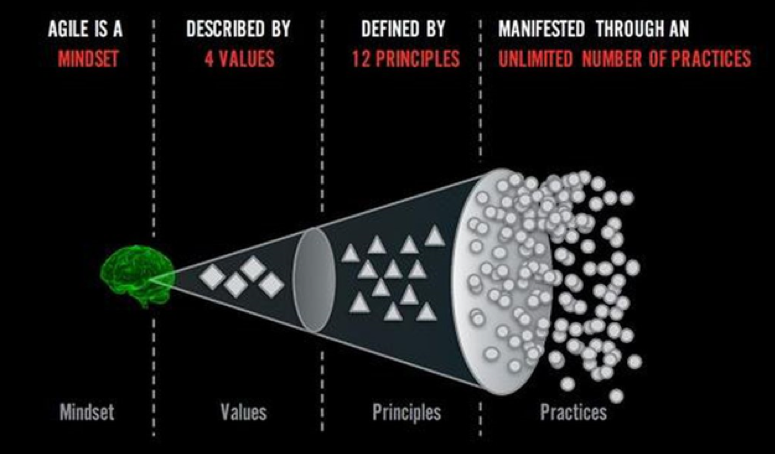Business Agility is finally going mainstream, and it’s about time! From Lean Startups to large, traditionally bureaucratic corporations and federal agencies, individuals and teams across the spectrum of the professional world are dispelling the myth that Agile is only for technology. Through an Agile lens, these leaders and their organizations are discovering powerful new ways to evolve, deliver real value to their customers, and improve the daily work lives of the people who make it happen.
The potential for using Agile to accomplish broader objectives was always there, even if the rest of the business world wasn’t quite ready to accept it. Admittedly, I struggled for a long time trying to help leaders outside of IT understand the possibilities for Agile within their organizations. “Agile is not Scrum!” I would insist to people of influence, “And it’s not just an IT thing!” But the critical connection remained elusive for many who saw Agile as defined by and limited to software development.
My solution to this common preconception arrived in 2016, at a one-day seminar titled The Agile Mindset for Project Managers. It was delivered by Dr. Ahmed Sidky, now the President of the world-renowned International Consortium for Agile, or ICAgile. One slide resonated with me as particularly meaningful, and the message it conveyed is something that I still bring to each new coaching engagement:

Treating Agile holistically – as a mindset reflected in the things you do – changed the game for how I approached my coaching and my conversations on the subject. It was also a likely contributor to the broader positive shift in perceptions of Business Agility. Fast forward to 2018 – the Agile world abounds with talk about the Agile mindset and “being” Agile in new industries and across all facets of a business.
Agile for Everyone
That simple but powerful description provides a whole new way of talking about Agile. By describing it as a mindset we free it from the limitations of frameworks and methods, and can better explain its potential to solve our customers’ real business problems, both within and outside of IT. But we must also recognize the need for balance – that the potential of Agile is realized only by acknowledging a potentially infinite number of practices, and it’s the two sides together that create the catalyst for Agile to expand into fresh territory: marketing, management, banking, you name it.
Much has changed in a brief time, with the influence of Agile expanding in new and exciting ways:
- Innovative frameworks and practices have risen while Kanban continues to grow in popularity.
- Industries and specialties outside of software are developing their own takes on the original Manifesto for Agile Software Development.
- The number of speaking circuits and conferences on Business Agility are steadily increasing.
- Steve Denning keeps writing excellent books on the subject, including his latest, The Age of Agile: How Smart Companies Are Transforming the Way Work Gets Done.
Even Dr. Sidky’s ICAgile recently launched a new track on Business Agility that covers leadership, HR and marketing. The common theme across all of these trends is this: If you exist in a world of knowledge work, where you think for a living and apply empiricism (whether you realize it or not), then you can benefit from the Agile mindset and its infinite number of practices, including the ones that may not even exist yet!
A Case Study in Business Agility: Partnering with Silverline Communications
In August 2017, Excella partnered with Silverline Communications to help them apply the Agile mindset and practices within their growing marketing firm. As Laura Taylor (Silverline CEO) describes in her earlier post, she knew from conversations with her husband, an Agile coach, that this mindset shift enabled significant new opportunities for technology teams. Her curiosity and eagerness to explore the potential benefits for her own organization led to our work together.
The Silverline team was well-suited for the task: they were motivated, eager to learn and had already begun experimenting with Agile concepts on their own. What they needed was some guidance to maximize the effectiveness of their transition, and I was asked to coach the effort from the Excella side.
So why did Excella choose marketing for its first case study on Business Agility? In many ways, it was an optimal choice:
- Marketing is knowledge work that balances dynamic content creation and services. It requires rapid adaptation to shifting priorities in a competitive, always-shifting landscape.
- Marketers themselves are natural communicators and collaborators who are open to change and innovation – they know they can’t stay idle and expect to survive.
- Perhaps most important, marketers are creative people who continuously experiment to solve their customers’ problems and deliver real value. They even manage to have a little fun in the process!
These are all excellent foundations for Agile to help an organization thrive. In a few weeks, I’ll follow up with a post on how we started applying the Agile mindset at Silverline. Up next, their team will explain why you don’t need to go it alone (and probably shouldn’t), and what to look for specifically in an Agile coach if your organization operates in a domain outside of IT.
Last Updated: September 24, 2024